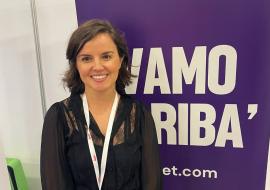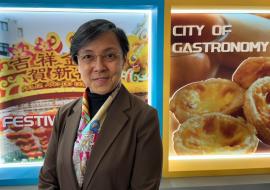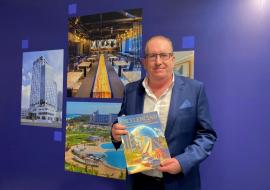Girona: Culture, History and Temps de Flors

Girona, capital of the Spanish province in Catalonia, has great historic, artistic and cultural heritage and over the past century it has held a one-of-a-kind festival: Temps de Flors, at one of the best-preserved ancient Jewish neighborhoods in Europe, a must-see place for numerous tourists, especially American visitors. Tourism and Trade Councilwoman for Girona City Hall, Corali Cunyat i Badosa, spoke exclusively with Caribbean News Digital.
Temps de Flors has been held since 1955, it’s been almost 60 years. How has it been and how has it evolved to the present and what has it meant to Girona?
-Indeed, it was created in that year as the initiative of a group of ladies who lived in the ancient neighborhood and were big fans of the floral universe. They decided to create a flower contest so the enthusiasts could show who had the most beautiful or extravagant flowers; the word is that some families event traveled to Paris in an effort to obtain different flowers. That’s how Temps de Flors came up. It was organized by those founders over the years, along with hundreds of volunteers that helped them. It was initially related to Santo Domingo de Gerona church, but it evolved throughout the years and became an extraordinary show of flower creations and a tradition of the city.
Finally, since the project was gaining momentum, in mid 1990s the city hall decided to officially recognize it and hold the show all over the city. The monuments were decorated and the owners of backyards within the Old Neighborhood were convinced to open them to the public. Of course, we haven’t forgotten about the participation of founders and volunteers that made it possible. Some of them are still working on the organization and, although they are elderly people, they help us to choose the projects, decide about the locations and the relations with owners of these properties that are open throughout the exhibition to install floral projects.
With that great transformation the festival turned into the current Girona, Temps de Flors, when creators cover the city with classic or experimental shows, in most of monuments, public and private spaces. Nowadays, the festival, which is carried out on the third week of May, has adopted promotional, touristic and commercial character; thus becoming one of the city’s most important annual events and a national benchmark, also continental, when over one hundred artistic projects deck gardens, backyards and monuments with flowers, positioning Girona right in the spring epicenter of Catalonia.
Why do people say that Girona is a tailor-made city for any season of the year?
-It’s a made-to-measure city because, despite of been a great destination, it has dimensions that are comfortable enough to enjoy all the tourism products we offer. It can be visited round the year because we hold musical and cultural festivals every month, thus giving visitors the opportunity to enjoy the city’s magnificent historic, cultural and gastronomic heritage, as well as several activities.
What kind of activities?
-This year we have launched an important bet from the city hall to consolidate our position as a city of musical festivals. We have all kinds of events, programs with classic and modern music, which complement the Auditorium’s permanent program, so the city has offers for all types of audiences throughout most of the year’s weeks. These activities include a wide range of national and internationally acclaimed classic artists, who give concerts at the Auditorium, as well as modern musicians that participate in festivals targeting young people.
Beyond the cultural and historic tourism, you also have a great convention center. Are you obtaining the results you were expecting in terms of this tourism sector?
-We have an annual increase in terms of congresses held in the city. Some time ago, we had a weak spot related to the scarce connection with other cities, but this year, in January, the high-speed train or AVE was inaugurated and connected us with Barcelona, Zaragoza, Madrid and even Paris, Montpellier and other foreign cities. It’s a door to new markets and congress organizers expected that, with this new train reaching the city, the number of events would see an increase. And that’s what has happened indeed, it’s a great opportunity that has boosted our tourism.
What are the most important outbound markets for you?
-Our official data shows that visitors coming from the rest of Catalonia’s cities, 26,95 % of the total, represent the larger figure, followed by the French with 13,26%; Netherlands with 6,3%; United Kingdom with 6,23%; the Community of Madrid with 5,06%, and Russia with 4,62%. We must highlight the growing number of visitors from the United States, with an increase of nearly 168%.
What is this increase related to? How much does Russian tourism chip in to these figures?
-In the case of Russia we must not forget that Gerona-Costa Brava airport is located just 12 km away from the city. It was previously aimed at domestic and charter flights, but it presently features a high-end infrastructure operated by several airlines, and also represents the base in the south of Europe of one of the largest low-cost companies, Ryanair, which has flights connecting Girona and Russia.
As for the Americans, there are two key elements: our Jew neighborhood, one of the best preserved in Europe and an icon for American Jewish people that specifically come to visit it. This “Call Jueu” is within the crossroads of medieval alleys in the city, where that community was based until late 20th century. Bonastruc Ça Porta Center stands out since it’s an ancient synagogue that became a studies center and Museum of Jews History. The medieval Jewish graveyard was located to the north of the city, in Montjuic Mountain, or mountain of the Jewish people. On the other hand, National Geographic magazine, on its US issue, chose Girona city as one of the top ten world destinations to be visited in spring, what represented a spectacular promotion platform and boosted the number of Americans visiting us.
Do you have any developments in the offing?
-We want to foster the amount of parallel cultural activities to complement the exhibition ad floral projects, and that’s the reason why we are investing more than ever in musical festivals. We’ll have a “mapping” screening on the façade of the city hall to shed light on the works exhibited in our museums; we’re going to celebrate the International Day of Museums, the European Day of Opera. So, we’ll be using all our cultural resources to complement our great flower festival and have more visitors coming and staying in our city, which welcomes them with open arms and great hospitality.














